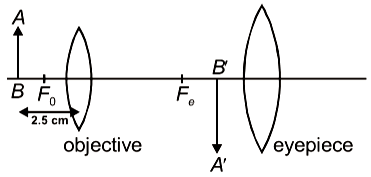A ray of light falls on a transparent sphere as shown in the figure. If the final ray emerges from the sphere parallel to the horizontal diameter, then calculate the refractive index of the sphere. Consider that the sphere is kept in the air.

1.
\(\sqrt{2}\)
2.
\(\sqrt{3}\)
3.
\(\sqrt{3 / 2}\)
4.
\(\sqrt{4 / 3}\)
A small telescope has an objective lens of focal length 144 cm and an eye-piece of focal length 6.0 cm. The magnifying power of the telescope is ( when the final image is at infinity)
1. 24
2. 25
3. 30
4. 150
The focal length of the plano-convex lens is 20 cm. If its plane surface is silvered, then
1. it behaves as a concave mirror of focal length 10 cm
2. it behaves as a convex mirror of focal length of 10 cm
3. it behaves as a concave mirror of focal length 20 cm
4. none of these
The critical angle for prism is 36. The maximum angle of prism for which the emergent ray is possible is:
1.
2.
3.
4.
When a ray is refracted from one medium to another, the wavelength changes from 6000 to 4000. The critical angle for the interface will be:
1.
2.
3.
4.
The sun (diameter D) subtends an angle radian at the pole of a concave mirror of focal length f. The diameter of the image of the sun formed by the mirror is:
1.
2.
3.
4.
In the situation shown, the incident monochromatic ray retraces its path after its incidence on the silvered surface. The speed of light inside the prism will be

1.
2.
3.
4.
| 1. | \(10\) cm and \(80\) cm |
| 2. | \(85\) cm and \(5\) cm |
| 3. | \(70\) cm and \(20\) cm |
| 4. | \(5\) cm and \(85\) cm |
Two identical equiconvex thin lenses each of focal lengths \(20\) cm, made of material of refractive index \(1.5\) are placed coaxially in contact as shown. Now, the space between them is filled with a liquid with a refractive index of \(1.5\). The equivalent power of this arrangement will be:

| 1. | \(+5\) D | 2. | zero |
| 3. | \(+2.5\) D | 4. | \(+0.5\) D |
Focal lengths of objective and eyepiece of a compound microscope are 2 cm and 6.25 cm respectively. An object AB is placed at a distance of 2.5 cm from the objective which forms the image B'A' as shown in the figure. Maximum magnifying power in this case is :


1. 10
2. 20
3. 5
4. 25






